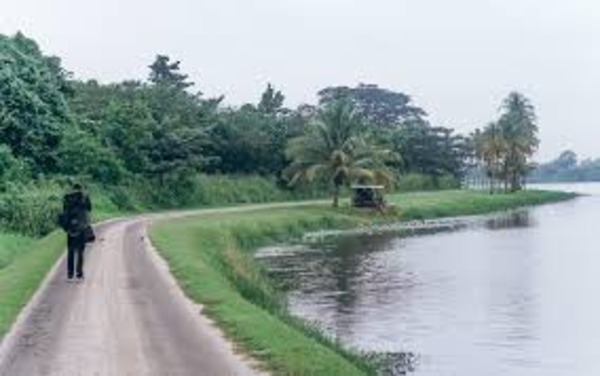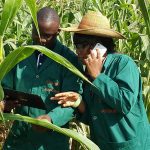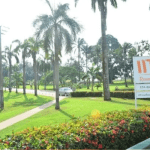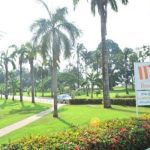IITA Forest Centre has been making positive headlines in reforestation since 2015.
The Centre in a recently published scientific paper, IITA Forest Centre reports its groundbreaking impacts over the last eight years.
These impacts cut across the environmental, social, and economic spaces, significantly contributing to the accomplishment of SDG 13 and 15 in positive climate solutions and improved life on land.
As a key driver of reforestation solutions in Africa, IITA Forest Centre knows that the choice of tree species is crucial to the success of reforestation programs worldwide.
Native tree species protect the African landscape, preserve endemic biodiversity, and serve better ecosystem services and functions than non-native tree species.
However, many reforestation stakeholders in Africa opt for non-native tree species (NNTs) for quick income to support their families despite their acknowledgment of the benefits of planting native tree species over NNTs.
What are their major inhibitors? They are the lack of information, availability of seeds, and suitable propagation techniques.
Some conservation stakeholders believe that certain trees are planted by the gods simply because efforts to propagate and plant them have proven abortive.
To mitigate the shortage of propagation information and lack of expertise in propagating native trees, IITA Forest Centre developed an easy-to-read and freely downloadable Manual of Tree Propagation (MTP) for forest and conservation stakeholders.
In eight years, over 1,000 propagation modules of 55 different native tree species uploaded on IITA Forest Centre’s website have been downloaded across 15 countries worldwide.
This data retrieved, using Google Analytics, reveals interesting impacts and huge success reports for IITA Forest Centre.
The seven African countries (Benin Republic, Cameroon, Côte d’Ivoire, DR Congo, Ghana, Nigeria, and Uganda) where IITA Forest Centre’s MTP was downloaded are in the tropical belt and share similar floristic composition.
This suggests there had been actual engagement of the downloaded MTP for knowledge and adoption, boosting the use of native tree species for reforestation in West Africa.
Meanwhile, downloads from non-African countries, including Finland, Germany, Guyana, India, Indonesia, New Zealand, the United Kingdom, and the United States, suggest the use of the MTP for academic purposes as grey literature.
This further gives credence to the Forest Centre’s conservation mantra to ‘think globally and act locally’.
Nigeria had the highest number of downloads, recording 693 out of 1013 downloads; this is justifiable as Nigeria is the country location of IITA Forest Center’s Nigerian Threatened Native Trees Project, sponsoring this research and conservation activities.
Interestingly, Agbalumo (Gambeya albida species), Prekese (Tetrapleura tetraptera species), and Bitter kola (Garcinia kola species) were the top three most downloaded species.
These are valued for their non-timber products and reveal where the interests of reforestation stakeholders in the African tropics lie. Agbalumo and prekese mature earlier than timber tree species like the African teak Milicia excelsa.
The high number of these downloads suggests foresters are exploring environmentally friendly solutions while they ensure a high-income yield.
However, bitter kola is very difficult to propagate.
IITA Forest Centre has set the tone for revolutionizing reforestation by sharing practical ways to propagate native species instead of non-natives.
The current gains of IITA Forest Centre are highly applauded.
Over 140 foresters (114 men and 32 women) trained during the project phase go ahead to implement and teach others the propagation skills they learned at IITA Forest Centre.
Currently, 1,200 hectares of degraded forests in Olokemeji, Emerald, and Crescendo Africa forest reserves are being reforested using the MTP modules for raising tree seedlings.
Eight project beneficiaries were interviewed to track the skills gained and adoption levels in their reforestation fields.
They attested to spreading the proven knowledge gained to other foresters, rangers, and conservation consultants who aim to collect propagules.
Graduate trainees use the MTP for their academic work. The Head of IITA Forest Centre, Adewale Awoyemi, is immensely impressed at the impact IITA Forest Centre is making in the conservation space.
He said, “Our results show the wider relevance our local conservation project is making globally. We are delighted to see these impacts and will continue to do more thinking globally to act locally, as our mantra states.” He also charged conservation partners to prioritize monitoring the impacts of their conservation works alongside their various conservation efforts.
IITA Forest Centre has been making positive headlines in reforestation since 2015.
The Centre in a recently published scientific paper, IITA Forest Centre reports its groundbreaking impacts over the last eight years.
These impacts cut across the environmental, social, and economic spaces, significantly contributing to the accomplishment of SDG 13 and 15 in positive climate solutions and improved life on land.
As a key driver of reforestation solutions in Africa, IITA Forest Centre knows that the choice of tree species is crucial to the success of reforestation programs worldwide.
Native tree species protect the African landscape, preserve endemic biodiversity, and serve better ecosystem services and functions than non-native tree species.
However, many reforestation stakeholders in Africa opt for non-native tree species (NNTs) for quick income to support their families despite their acknowledgment of the benefits of planting native tree species over NNTs.
What are their major inhibitors? They are the lack of information, availability of seeds, and suitable propagation techniques.
Some conservation stakeholders believe that certain trees are planted by the gods simply because efforts to propagate and plant them have proven abortive.
To mitigate the shortage of propagation information and lack of expertise in propagating native trees, IITA Forest Centre developed an easy-to-read and freely downloadable Manual of Tree Propagation (MTP) for forest and conservation stakeholders.
In eight years, over 1,000 propagation modules of 55 different native tree species uploaded on IITA Forest Centre’s website have been downloaded across 15 countries worldwide.
This data retrieved, using Google Analytics, reveals interesting impacts and huge success reports for IITA Forest Centre.
The seven African countries (Benin Republic, Cameroon, Côte d’Ivoire, DR Congo, Ghana, Nigeria, and Uganda) where IITA Forest Centre’s MTP was downloaded are in the tropical belt and share similar floristic composition.
This suggests there had been actual engagement of the downloaded MTP for knowledge and adoption, boosting the use of native tree species for reforestation in West Africa.
Meanwhile, downloads from non-African countries, including Finland, Germany, Guyana, India, Indonesia, New Zealand, the United Kingdom, and the United States, suggest the use of the MTP for academic purposes as grey literature.
This further gives credence to the Forest Centre’s conservation mantra to ‘think globally and act locally’.
Nigeria had the highest number of downloads, recording 693 out of 1013 downloads; this is justifiable as Nigeria is the country location of IITA Forest Center’s Nigerian Threatened Native Trees Project, sponsoring this research and conservation activities.
Interestingly, Agbalumo (Gambeya albida species), Prekese (Tetrapleura tetraptera species), and Bitter kola (Garcinia kola species) were the top three most downloaded species.
These are valued for their non-timber products and reveal where the interests of reforestation stakeholders in the African tropics lie. Agbalumo and prekese mature earlier than timber tree species like the African teak Milicia excelsa.
The high number of these downloads suggests foresters are exploring environmentally friendly solutions while they ensure a high-income yield.
However, bitter kola is very difficult to propagate.
IITA Forest Centre has set the tone for revolutionizing reforestation by sharing practical ways to propagate native species instead of non-natives.
The current gains of IITA Forest Centre are highly applauded.
Over 140 foresters (114 men and 32 women) trained during the project phase go ahead to implement and teach others the propagation skills they learned at IITA Forest Centre.
Currently, 1,200 hectares of degraded forests in Olokemeji, Emerald, and Crescendo Africa forest reserves are being reforested using the MTP modules for raising tree seedlings.
Eight project beneficiaries were interviewed to track the skills gained and adoption levels in their reforestation fields.
They attested to spreading the proven knowledge gained to other foresters, rangers, and conservation consultants who aim to collect propagules.
Graduate trainees use the MTP for their academic work. The Head of IITA Forest Centre, Adewale Awoyemi, is immensely impressed at the impact IITA Forest Centre is making in the conservation space.
He said, “Our results show the wider relevance our local conservation project is making globally. We are delighted to see these impacts and will continue to do more thinking globally to act locally, as our mantra states.” He also charged conservation partners to prioritize monitoring the impacts of their conservation works alongside their various conservation efforts.
IITA Forest Centre has been making positive headlines in reforestation since 2015.
The Centre in a recently published scientific paper, IITA Forest Centre reports its groundbreaking impacts over the last eight years.
These impacts cut across the environmental, social, and economic spaces, significantly contributing to the accomplishment of SDG 13 and 15 in positive climate solutions and improved life on land.
As a key driver of reforestation solutions in Africa, IITA Forest Centre knows that the choice of tree species is crucial to the success of reforestation programs worldwide.
Native tree species protect the African landscape, preserve endemic biodiversity, and serve better ecosystem services and functions than non-native tree species.
However, many reforestation stakeholders in Africa opt for non-native tree species (NNTs) for quick income to support their families despite their acknowledgment of the benefits of planting native tree species over NNTs.
What are their major inhibitors? They are the lack of information, availability of seeds, and suitable propagation techniques.
Some conservation stakeholders believe that certain trees are planted by the gods simply because efforts to propagate and plant them have proven abortive.
To mitigate the shortage of propagation information and lack of expertise in propagating native trees, IITA Forest Centre developed an easy-to-read and freely downloadable Manual of Tree Propagation (MTP) for forest and conservation stakeholders.
In eight years, over 1,000 propagation modules of 55 different native tree species uploaded on IITA Forest Centre’s website have been downloaded across 15 countries worldwide.
This data retrieved, using Google Analytics, reveals interesting impacts and huge success reports for IITA Forest Centre.
The seven African countries (Benin Republic, Cameroon, Côte d’Ivoire, DR Congo, Ghana, Nigeria, and Uganda) where IITA Forest Centre’s MTP was downloaded are in the tropical belt and share similar floristic composition.
This suggests there had been actual engagement of the downloaded MTP for knowledge and adoption, boosting the use of native tree species for reforestation in West Africa.
Meanwhile, downloads from non-African countries, including Finland, Germany, Guyana, India, Indonesia, New Zealand, the United Kingdom, and the United States, suggest the use of the MTP for academic purposes as grey literature.
This further gives credence to the Forest Centre’s conservation mantra to ‘think globally and act locally’.
Nigeria had the highest number of downloads, recording 693 out of 1013 downloads; this is justifiable as Nigeria is the country location of IITA Forest Center’s Nigerian Threatened Native Trees Project, sponsoring this research and conservation activities.
Interestingly, Agbalumo (Gambeya albida species), Prekese (Tetrapleura tetraptera species), and Bitter kola (Garcinia kola species) were the top three most downloaded species.
These are valued for their non-timber products and reveal where the interests of reforestation stakeholders in the African tropics lie. Agbalumo and prekese mature earlier than timber tree species like the African teak Milicia excelsa.
The high number of these downloads suggests foresters are exploring environmentally friendly solutions while they ensure a high-income yield.
However, bitter kola is very difficult to propagate.
IITA Forest Centre has set the tone for revolutionizing reforestation by sharing practical ways to propagate native species instead of non-natives.
The current gains of IITA Forest Centre are highly applauded.
Over 140 foresters (114 men and 32 women) trained during the project phase go ahead to implement and teach others the propagation skills they learned at IITA Forest Centre.
Currently, 1,200 hectares of degraded forests in Olokemeji, Emerald, and Crescendo Africa forest reserves are being reforested using the MTP modules for raising tree seedlings.
Eight project beneficiaries were interviewed to track the skills gained and adoption levels in their reforestation fields.
They attested to spreading the proven knowledge gained to other foresters, rangers, and conservation consultants who aim to collect propagules.
Graduate trainees use the MTP for their academic work. The Head of IITA Forest Centre, Adewale Awoyemi, is immensely impressed at the impact IITA Forest Centre is making in the conservation space.
He said, “Our results show the wider relevance our local conservation project is making globally. We are delighted to see these impacts and will continue to do more thinking globally to act locally, as our mantra states.” He also charged conservation partners to prioritize monitoring the impacts of their conservation works alongside their various conservation efforts.
IITA Forest Centre has been making positive headlines in reforestation since 2015.
The Centre in a recently published scientific paper, IITA Forest Centre reports its groundbreaking impacts over the last eight years.
These impacts cut across the environmental, social, and economic spaces, significantly contributing to the accomplishment of SDG 13 and 15 in positive climate solutions and improved life on land.
As a key driver of reforestation solutions in Africa, IITA Forest Centre knows that the choice of tree species is crucial to the success of reforestation programs worldwide.
Native tree species protect the African landscape, preserve endemic biodiversity, and serve better ecosystem services and functions than non-native tree species.
However, many reforestation stakeholders in Africa opt for non-native tree species (NNTs) for quick income to support their families despite their acknowledgment of the benefits of planting native tree species over NNTs.
What are their major inhibitors? They are the lack of information, availability of seeds, and suitable propagation techniques.
Some conservation stakeholders believe that certain trees are planted by the gods simply because efforts to propagate and plant them have proven abortive.
To mitigate the shortage of propagation information and lack of expertise in propagating native trees, IITA Forest Centre developed an easy-to-read and freely downloadable Manual of Tree Propagation (MTP) for forest and conservation stakeholders.
In eight years, over 1,000 propagation modules of 55 different native tree species uploaded on IITA Forest Centre’s website have been downloaded across 15 countries worldwide.
This data retrieved, using Google Analytics, reveals interesting impacts and huge success reports for IITA Forest Centre.
The seven African countries (Benin Republic, Cameroon, Côte d’Ivoire, DR Congo, Ghana, Nigeria, and Uganda) where IITA Forest Centre’s MTP was downloaded are in the tropical belt and share similar floristic composition.
This suggests there had been actual engagement of the downloaded MTP for knowledge and adoption, boosting the use of native tree species for reforestation in West Africa.
Meanwhile, downloads from non-African countries, including Finland, Germany, Guyana, India, Indonesia, New Zealand, the United Kingdom, and the United States, suggest the use of the MTP for academic purposes as grey literature.
This further gives credence to the Forest Centre’s conservation mantra to ‘think globally and act locally’.
Nigeria had the highest number of downloads, recording 693 out of 1013 downloads; this is justifiable as Nigeria is the country location of IITA Forest Center’s Nigerian Threatened Native Trees Project, sponsoring this research and conservation activities.
Interestingly, Agbalumo (Gambeya albida species), Prekese (Tetrapleura tetraptera species), and Bitter kola (Garcinia kola species) were the top three most downloaded species.
These are valued for their non-timber products and reveal where the interests of reforestation stakeholders in the African tropics lie. Agbalumo and prekese mature earlier than timber tree species like the African teak Milicia excelsa.
The high number of these downloads suggests foresters are exploring environmentally friendly solutions while they ensure a high-income yield.
However, bitter kola is very difficult to propagate.
IITA Forest Centre has set the tone for revolutionizing reforestation by sharing practical ways to propagate native species instead of non-natives.
The current gains of IITA Forest Centre are highly applauded.
Over 140 foresters (114 men and 32 women) trained during the project phase go ahead to implement and teach others the propagation skills they learned at IITA Forest Centre.
Currently, 1,200 hectares of degraded forests in Olokemeji, Emerald, and Crescendo Africa forest reserves are being reforested using the MTP modules for raising tree seedlings.
Eight project beneficiaries were interviewed to track the skills gained and adoption levels in their reforestation fields.
They attested to spreading the proven knowledge gained to other foresters, rangers, and conservation consultants who aim to collect propagules.
Graduate trainees use the MTP for their academic work. The Head of IITA Forest Centre, Adewale Awoyemi, is immensely impressed at the impact IITA Forest Centre is making in the conservation space.
He said, “Our results show the wider relevance our local conservation project is making globally. We are delighted to see these impacts and will continue to do more thinking globally to act locally, as our mantra states.” He also charged conservation partners to prioritize monitoring the impacts of their conservation works alongside their various conservation efforts.
IITA Forest Centre has been making positive headlines in reforestation since 2015.
The Centre in a recently published scientific paper, IITA Forest Centre reports its groundbreaking impacts over the last eight years.
These impacts cut across the environmental, social, and economic spaces, significantly contributing to the accomplishment of SDG 13 and 15 in positive climate solutions and improved life on land.
As a key driver of reforestation solutions in Africa, IITA Forest Centre knows that the choice of tree species is crucial to the success of reforestation programs worldwide.
Native tree species protect the African landscape, preserve endemic biodiversity, and serve better ecosystem services and functions than non-native tree species.
However, many reforestation stakeholders in Africa opt for non-native tree species (NNTs) for quick income to support their families despite their acknowledgment of the benefits of planting native tree species over NNTs.
What are their major inhibitors? They are the lack of information, availability of seeds, and suitable propagation techniques.
Some conservation stakeholders believe that certain trees are planted by the gods simply because efforts to propagate and plant them have proven abortive.
To mitigate the shortage of propagation information and lack of expertise in propagating native trees, IITA Forest Centre developed an easy-to-read and freely downloadable Manual of Tree Propagation (MTP) for forest and conservation stakeholders.
In eight years, over 1,000 propagation modules of 55 different native tree species uploaded on IITA Forest Centre’s website have been downloaded across 15 countries worldwide.
This data retrieved, using Google Analytics, reveals interesting impacts and huge success reports for IITA Forest Centre.
The seven African countries (Benin Republic, Cameroon, Côte d’Ivoire, DR Congo, Ghana, Nigeria, and Uganda) where IITA Forest Centre’s MTP was downloaded are in the tropical belt and share similar floristic composition.
This suggests there had been actual engagement of the downloaded MTP for knowledge and adoption, boosting the use of native tree species for reforestation in West Africa.
Meanwhile, downloads from non-African countries, including Finland, Germany, Guyana, India, Indonesia, New Zealand, the United Kingdom, and the United States, suggest the use of the MTP for academic purposes as grey literature.
This further gives credence to the Forest Centre’s conservation mantra to ‘think globally and act locally’.
Nigeria had the highest number of downloads, recording 693 out of 1013 downloads; this is justifiable as Nigeria is the country location of IITA Forest Center’s Nigerian Threatened Native Trees Project, sponsoring this research and conservation activities.
Interestingly, Agbalumo (Gambeya albida species), Prekese (Tetrapleura tetraptera species), and Bitter kola (Garcinia kola species) were the top three most downloaded species.
These are valued for their non-timber products and reveal where the interests of reforestation stakeholders in the African tropics lie. Agbalumo and prekese mature earlier than timber tree species like the African teak Milicia excelsa.
The high number of these downloads suggests foresters are exploring environmentally friendly solutions while they ensure a high-income yield.
However, bitter kola is very difficult to propagate.
IITA Forest Centre has set the tone for revolutionizing reforestation by sharing practical ways to propagate native species instead of non-natives.
The current gains of IITA Forest Centre are highly applauded.
Over 140 foresters (114 men and 32 women) trained during the project phase go ahead to implement and teach others the propagation skills they learned at IITA Forest Centre.
Currently, 1,200 hectares of degraded forests in Olokemeji, Emerald, and Crescendo Africa forest reserves are being reforested using the MTP modules for raising tree seedlings.
Eight project beneficiaries were interviewed to track the skills gained and adoption levels in their reforestation fields.
They attested to spreading the proven knowledge gained to other foresters, rangers, and conservation consultants who aim to collect propagules.
Graduate trainees use the MTP for their academic work. The Head of IITA Forest Centre, Adewale Awoyemi, is immensely impressed at the impact IITA Forest Centre is making in the conservation space.
He said, “Our results show the wider relevance our local conservation project is making globally. We are delighted to see these impacts and will continue to do more thinking globally to act locally, as our mantra states.” He also charged conservation partners to prioritize monitoring the impacts of their conservation works alongside their various conservation efforts.
IITA Forest Centre has been making positive headlines in reforestation since 2015.
The Centre in a recently published scientific paper, IITA Forest Centre reports its groundbreaking impacts over the last eight years.
These impacts cut across the environmental, social, and economic spaces, significantly contributing to the accomplishment of SDG 13 and 15 in positive climate solutions and improved life on land.
As a key driver of reforestation solutions in Africa, IITA Forest Centre knows that the choice of tree species is crucial to the success of reforestation programs worldwide.
Native tree species protect the African landscape, preserve endemic biodiversity, and serve better ecosystem services and functions than non-native tree species.
However, many reforestation stakeholders in Africa opt for non-native tree species (NNTs) for quick income to support their families despite their acknowledgment of the benefits of planting native tree species over NNTs.
What are their major inhibitors? They are the lack of information, availability of seeds, and suitable propagation techniques.
Some conservation stakeholders believe that certain trees are planted by the gods simply because efforts to propagate and plant them have proven abortive.
To mitigate the shortage of propagation information and lack of expertise in propagating native trees, IITA Forest Centre developed an easy-to-read and freely downloadable Manual of Tree Propagation (MTP) for forest and conservation stakeholders.
In eight years, over 1,000 propagation modules of 55 different native tree species uploaded on IITA Forest Centre’s website have been downloaded across 15 countries worldwide.
This data retrieved, using Google Analytics, reveals interesting impacts and huge success reports for IITA Forest Centre.
The seven African countries (Benin Republic, Cameroon, Côte d’Ivoire, DR Congo, Ghana, Nigeria, and Uganda) where IITA Forest Centre’s MTP was downloaded are in the tropical belt and share similar floristic composition.
This suggests there had been actual engagement of the downloaded MTP for knowledge and adoption, boosting the use of native tree species for reforestation in West Africa.
Meanwhile, downloads from non-African countries, including Finland, Germany, Guyana, India, Indonesia, New Zealand, the United Kingdom, and the United States, suggest the use of the MTP for academic purposes as grey literature.
This further gives credence to the Forest Centre’s conservation mantra to ‘think globally and act locally’.
Nigeria had the highest number of downloads, recording 693 out of 1013 downloads; this is justifiable as Nigeria is the country location of IITA Forest Center’s Nigerian Threatened Native Trees Project, sponsoring this research and conservation activities.
Interestingly, Agbalumo (Gambeya albida species), Prekese (Tetrapleura tetraptera species), and Bitter kola (Garcinia kola species) were the top three most downloaded species.
These are valued for their non-timber products and reveal where the interests of reforestation stakeholders in the African tropics lie. Agbalumo and prekese mature earlier than timber tree species like the African teak Milicia excelsa.
The high number of these downloads suggests foresters are exploring environmentally friendly solutions while they ensure a high-income yield.
However, bitter kola is very difficult to propagate.
IITA Forest Centre has set the tone for revolutionizing reforestation by sharing practical ways to propagate native species instead of non-natives.
The current gains of IITA Forest Centre are highly applauded.
Over 140 foresters (114 men and 32 women) trained during the project phase go ahead to implement and teach others the propagation skills they learned at IITA Forest Centre.
Currently, 1,200 hectares of degraded forests in Olokemeji, Emerald, and Crescendo Africa forest reserves are being reforested using the MTP modules for raising tree seedlings.
Eight project beneficiaries were interviewed to track the skills gained and adoption levels in their reforestation fields.
They attested to spreading the proven knowledge gained to other foresters, rangers, and conservation consultants who aim to collect propagules.
Graduate trainees use the MTP for their academic work. The Head of IITA Forest Centre, Adewale Awoyemi, is immensely impressed at the impact IITA Forest Centre is making in the conservation space.
He said, “Our results show the wider relevance our local conservation project is making globally. We are delighted to see these impacts and will continue to do more thinking globally to act locally, as our mantra states.” He also charged conservation partners to prioritize monitoring the impacts of their conservation works alongside their various conservation efforts.
IITA Forest Centre has been making positive headlines in reforestation since 2015.
The Centre in a recently published scientific paper, IITA Forest Centre reports its groundbreaking impacts over the last eight years.
These impacts cut across the environmental, social, and economic spaces, significantly contributing to the accomplishment of SDG 13 and 15 in positive climate solutions and improved life on land.
As a key driver of reforestation solutions in Africa, IITA Forest Centre knows that the choice of tree species is crucial to the success of reforestation programs worldwide.
Native tree species protect the African landscape, preserve endemic biodiversity, and serve better ecosystem services and functions than non-native tree species.
However, many reforestation stakeholders in Africa opt for non-native tree species (NNTs) for quick income to support their families despite their acknowledgment of the benefits of planting native tree species over NNTs.
What are their major inhibitors? They are the lack of information, availability of seeds, and suitable propagation techniques.
Some conservation stakeholders believe that certain trees are planted by the gods simply because efforts to propagate and plant them have proven abortive.
To mitigate the shortage of propagation information and lack of expertise in propagating native trees, IITA Forest Centre developed an easy-to-read and freely downloadable Manual of Tree Propagation (MTP) for forest and conservation stakeholders.
In eight years, over 1,000 propagation modules of 55 different native tree species uploaded on IITA Forest Centre’s website have been downloaded across 15 countries worldwide.
This data retrieved, using Google Analytics, reveals interesting impacts and huge success reports for IITA Forest Centre.
The seven African countries (Benin Republic, Cameroon, Côte d’Ivoire, DR Congo, Ghana, Nigeria, and Uganda) where IITA Forest Centre’s MTP was downloaded are in the tropical belt and share similar floristic composition.
This suggests there had been actual engagement of the downloaded MTP for knowledge and adoption, boosting the use of native tree species for reforestation in West Africa.
Meanwhile, downloads from non-African countries, including Finland, Germany, Guyana, India, Indonesia, New Zealand, the United Kingdom, and the United States, suggest the use of the MTP for academic purposes as grey literature.
This further gives credence to the Forest Centre’s conservation mantra to ‘think globally and act locally’.
Nigeria had the highest number of downloads, recording 693 out of 1013 downloads; this is justifiable as Nigeria is the country location of IITA Forest Center’s Nigerian Threatened Native Trees Project, sponsoring this research and conservation activities.
Interestingly, Agbalumo (Gambeya albida species), Prekese (Tetrapleura tetraptera species), and Bitter kola (Garcinia kola species) were the top three most downloaded species.
These are valued for their non-timber products and reveal where the interests of reforestation stakeholders in the African tropics lie. Agbalumo and prekese mature earlier than timber tree species like the African teak Milicia excelsa.
The high number of these downloads suggests foresters are exploring environmentally friendly solutions while they ensure a high-income yield.
However, bitter kola is very difficult to propagate.
IITA Forest Centre has set the tone for revolutionizing reforestation by sharing practical ways to propagate native species instead of non-natives.
The current gains of IITA Forest Centre are highly applauded.
Over 140 foresters (114 men and 32 women) trained during the project phase go ahead to implement and teach others the propagation skills they learned at IITA Forest Centre.
Currently, 1,200 hectares of degraded forests in Olokemeji, Emerald, and Crescendo Africa forest reserves are being reforested using the MTP modules for raising tree seedlings.
Eight project beneficiaries were interviewed to track the skills gained and adoption levels in their reforestation fields.
They attested to spreading the proven knowledge gained to other foresters, rangers, and conservation consultants who aim to collect propagules.
Graduate trainees use the MTP for their academic work. The Head of IITA Forest Centre, Adewale Awoyemi, is immensely impressed at the impact IITA Forest Centre is making in the conservation space.
He said, “Our results show the wider relevance our local conservation project is making globally. We are delighted to see these impacts and will continue to do more thinking globally to act locally, as our mantra states.” He also charged conservation partners to prioritize monitoring the impacts of their conservation works alongside their various conservation efforts.
IITA Forest Centre has been making positive headlines in reforestation since 2015.
The Centre in a recently published scientific paper, IITA Forest Centre reports its groundbreaking impacts over the last eight years.
These impacts cut across the environmental, social, and economic spaces, significantly contributing to the accomplishment of SDG 13 and 15 in positive climate solutions and improved life on land.
As a key driver of reforestation solutions in Africa, IITA Forest Centre knows that the choice of tree species is crucial to the success of reforestation programs worldwide.
Native tree species protect the African landscape, preserve endemic biodiversity, and serve better ecosystem services and functions than non-native tree species.
However, many reforestation stakeholders in Africa opt for non-native tree species (NNTs) for quick income to support their families despite their acknowledgment of the benefits of planting native tree species over NNTs.
What are their major inhibitors? They are the lack of information, availability of seeds, and suitable propagation techniques.
Some conservation stakeholders believe that certain trees are planted by the gods simply because efforts to propagate and plant them have proven abortive.
To mitigate the shortage of propagation information and lack of expertise in propagating native trees, IITA Forest Centre developed an easy-to-read and freely downloadable Manual of Tree Propagation (MTP) for forest and conservation stakeholders.
In eight years, over 1,000 propagation modules of 55 different native tree species uploaded on IITA Forest Centre’s website have been downloaded across 15 countries worldwide.
This data retrieved, using Google Analytics, reveals interesting impacts and huge success reports for IITA Forest Centre.
The seven African countries (Benin Republic, Cameroon, Côte d’Ivoire, DR Congo, Ghana, Nigeria, and Uganda) where IITA Forest Centre’s MTP was downloaded are in the tropical belt and share similar floristic composition.
This suggests there had been actual engagement of the downloaded MTP for knowledge and adoption, boosting the use of native tree species for reforestation in West Africa.
Meanwhile, downloads from non-African countries, including Finland, Germany, Guyana, India, Indonesia, New Zealand, the United Kingdom, and the United States, suggest the use of the MTP for academic purposes as grey literature.
This further gives credence to the Forest Centre’s conservation mantra to ‘think globally and act locally’.
Nigeria had the highest number of downloads, recording 693 out of 1013 downloads; this is justifiable as Nigeria is the country location of IITA Forest Center’s Nigerian Threatened Native Trees Project, sponsoring this research and conservation activities.
Interestingly, Agbalumo (Gambeya albida species), Prekese (Tetrapleura tetraptera species), and Bitter kola (Garcinia kola species) were the top three most downloaded species.
These are valued for their non-timber products and reveal where the interests of reforestation stakeholders in the African tropics lie. Agbalumo and prekese mature earlier than timber tree species like the African teak Milicia excelsa.
The high number of these downloads suggests foresters are exploring environmentally friendly solutions while they ensure a high-income yield.
However, bitter kola is very difficult to propagate.
IITA Forest Centre has set the tone for revolutionizing reforestation by sharing practical ways to propagate native species instead of non-natives.
The current gains of IITA Forest Centre are highly applauded.
Over 140 foresters (114 men and 32 women) trained during the project phase go ahead to implement and teach others the propagation skills they learned at IITA Forest Centre.
Currently, 1,200 hectares of degraded forests in Olokemeji, Emerald, and Crescendo Africa forest reserves are being reforested using the MTP modules for raising tree seedlings.
Eight project beneficiaries were interviewed to track the skills gained and adoption levels in their reforestation fields.
They attested to spreading the proven knowledge gained to other foresters, rangers, and conservation consultants who aim to collect propagules.
Graduate trainees use the MTP for their academic work. The Head of IITA Forest Centre, Adewale Awoyemi, is immensely impressed at the impact IITA Forest Centre is making in the conservation space.
He said, “Our results show the wider relevance our local conservation project is making globally. We are delighted to see these impacts and will continue to do more thinking globally to act locally, as our mantra states.” He also charged conservation partners to prioritize monitoring the impacts of their conservation works alongside their various conservation efforts.














